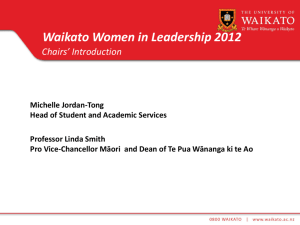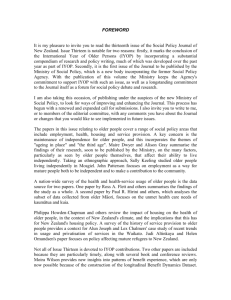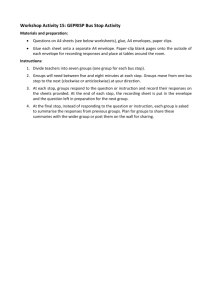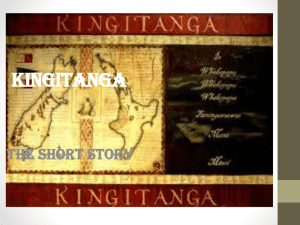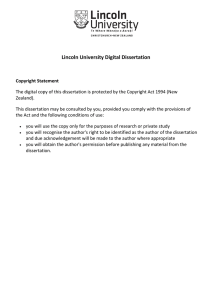War in the Waikato – activities for NCEA 3 History
advertisement
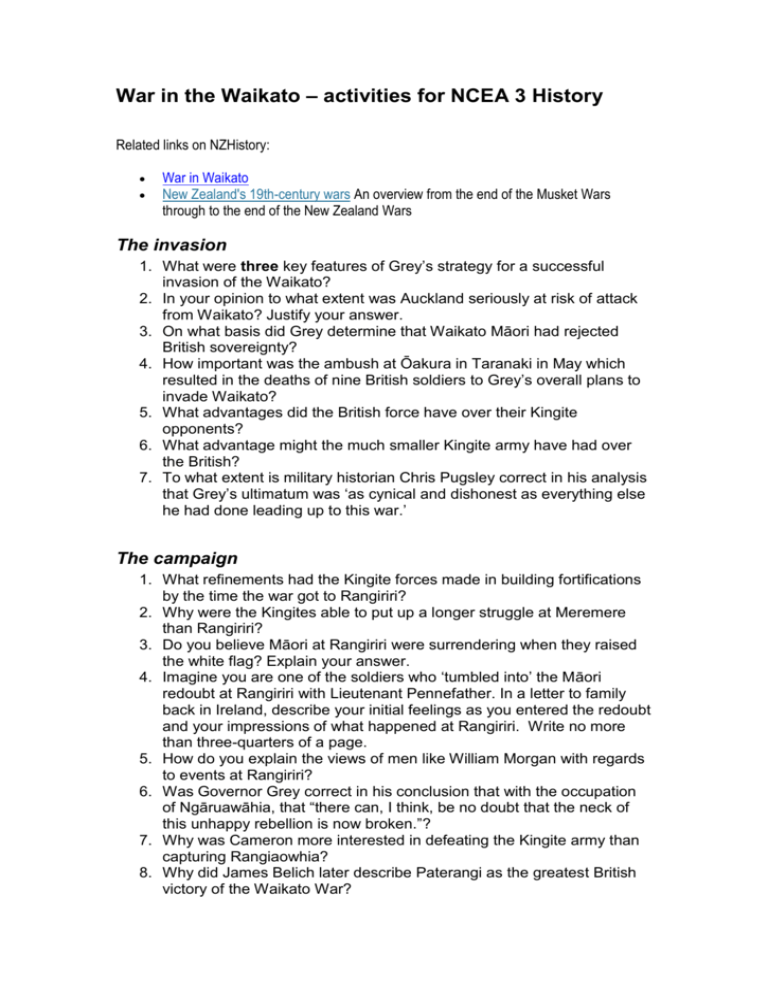
War in the Waikato – activities for NCEA 3 History Related links on NZHistory: War in Waikato New Zealand's 19th-century wars An overview from the end of the Musket Wars through to the end of the New Zealand Wars The invasion 1. What were three key features of Grey’s strategy for a successful invasion of the Waikato? 2. In your opinion to what extent was Auckland seriously at risk of attack from Waikato? Justify your answer. 3. On what basis did Grey determine that Waikato Māori had rejected British sovereignty? 4. How important was the ambush at Ōakura in Taranaki in May which resulted in the deaths of nine British soldiers to Grey’s overall plans to invade Waikato? 5. What advantages did the British force have over their Kingite opponents? 6. What advantage might the much smaller Kingite army have had over the British? 7. To what extent is military historian Chris Pugsley correct in his analysis that Grey’s ultimatum was ‘as cynical and dishonest as everything else he had done leading up to this war.’ The campaign 1. What refinements had the Kingite forces made in building fortifications by the time the war got to Rangiriri? 2. Why were the Kingites able to put up a longer struggle at Meremere than Rangiriri? 3. Do you believe Māori at Rangiriri were surrendering when they raised the white flag? Explain your answer. 4. Imagine you are one of the soldiers who ‘tumbled into’ the Māori redoubt at Rangiriri with Lieutenant Pennefather. In a letter to family back in Ireland, describe your initial feelings as you entered the redoubt and your impressions of what happened at Rangiriri. Write no more than three-quarters of a page. 5. How do you explain the views of men like William Morgan with regards to events at Rangiriri? 6. Was Governor Grey correct in his conclusion that with the occupation of Ngāruawāhia, that “there can, I think, be no doubt that the neck of this unhappy rebellion is now broken.”? 7. Why was Cameron more interested in defeating the Kingite army than capturing Rangiaowhia? 8. Why did James Belich later describe Paterangi as the greatest British victory of the Waikato War? 9. Why was Rewi unable to dissuade his allies from fighting at Ōrākau? 10. Why did Belich describe Ōrākau as ‘the cruellest disappointment of the entire war’ for the British? 11. Why were Ngāi te Rangi determined to provoke the British into fighting at the Gate Pā? 12. What lessons had the British failed to learn in the assault on Gate Pā? 13. What evidence is there in the aftermath of Gate Pā to suggest the Ngāi-te-Rangi reason for provoking the British was justified? 14. Was Cameron responsible for the defeat at Gate Pā? Explain your answer. 15. What was the impact of the fighting in the North Island on the rest of New Zealand at the time? Who won? This is a subject that for many generations of historians and others seemed obvious – the British won and victory ensured European dominance in New Zealand. It was pointed out that Māori lost considerable amounts of land in the aftermath and the Māori economy was left in tatters. With 500 Māori warriors killed or wounded any realistic threat had passed. Likewise the King Movement might have survived – just – but it was now in exile and of no real threat. The revision of this accepted interpretation was made most prominently by James Belich writing in the mid-1980s. The New Zealand Wars and the Victorian interpretation of racial conflict, presented a very different interpretation of events. Belich could point to comments in the contemporary press to suggest the British were being hasty in claiming success. The Wellington Spectator in April 1864 stated that ‘the supremacy of British arms has not yet been established’ while a few months later the New Zealand Herald believed that the Kingites ‘are far from being sufficiently humbled.’ When 200 Māori prisoners of war escaped from Kawau Island in September 1864 there were fears that more fighting was inevitable. The colonial ministry and Grey himself agreed further operations were required to win the war in the Waikato. The fact that the King Movement had survived, even if in exile in Ngāti Maniapoto territory was of sufficient concern to some Government ministers for them to call for an attack on Ngāti Maniapoto territory and Ngāti Hauā at Matamata. The fact that they did neither some concluded was clear evidence that Grey and his military leaders knew it wouldn’t succeed. 1. On the balance of what you have read do you believe it is possible to make a case for either side being able to claim victory in this conflict. Consider defining winning and losing in terms of the objectives of both sides. You can make a decision based on points if you feel a unanimous decision is not possible. Whatever you do you must justify your conclusion. 2. Draw a flow chart to show the cause and effect of the Waikato war. Consider some of the following points: Taranaki Population growth Asserting authority Settler government The Raupatu One major consequence for Māori following the fighting was the loss of land either as a result of the Native Land Court established in 1865 or via the raupatu or confiscation of land following the wars. With the removal of the Crown right of pre-emption and the destruction of tribal mana due to the courts power to determine the retention or disposal of Māori land, ‘land sharks, speculators and government land-purchase officers’ moved in to buy the land as soon as ‘owners’ got certificate of title. Ranginui Walker quotes a W. L. Reesa Cour, at the time as proclaiming that ‘the records of Maori land transactions will make the cheeks of our children burn with shame for many generations’. The loss of land was more than spiritual. It was a vital economic resource that sustained Māori. 1. Why was The New Zealand Settlements Act such an important part of the government’s policy of ‘taming the frontier’? 2. Soldiers were awarded parcels of land. Why? 3. On what grounds did the government assert its right to confiscate Māori land? 4. Why were Ngāti Maniapoto left alone when the Raupatu was applied? 5. Why could settlers only leave their land for no more than a month in the first three years of occupancy? 6. How were Māori disadvantaged by the proceedings in the Native Land Court? 7. Why would the records of Māori land transactions ‘make the cheeks of our children burn with shame for many generations’ according to W.L. Reesa Cour? 8. What do you believe were the main consequences of the policy of confiscation? Consider this in terms of short, medium and long-term effects. Summary Make a one page summary of the Waikato War. You could: use a diagram/s an annotated timeline bullet points or any other method that suits your learning style Consider some of the following points: the people and personalities e.g. similarities and differences and how they connect or relate to each other the events places features of the campaigns
